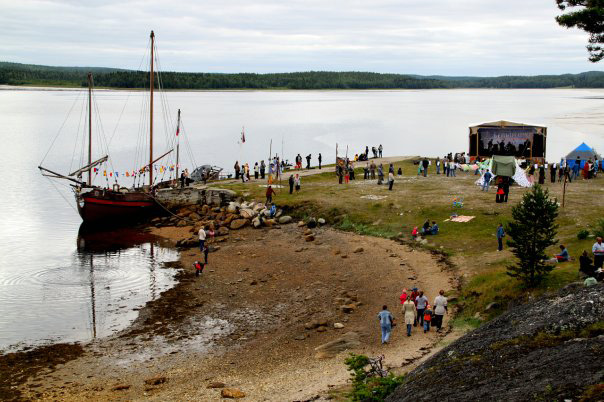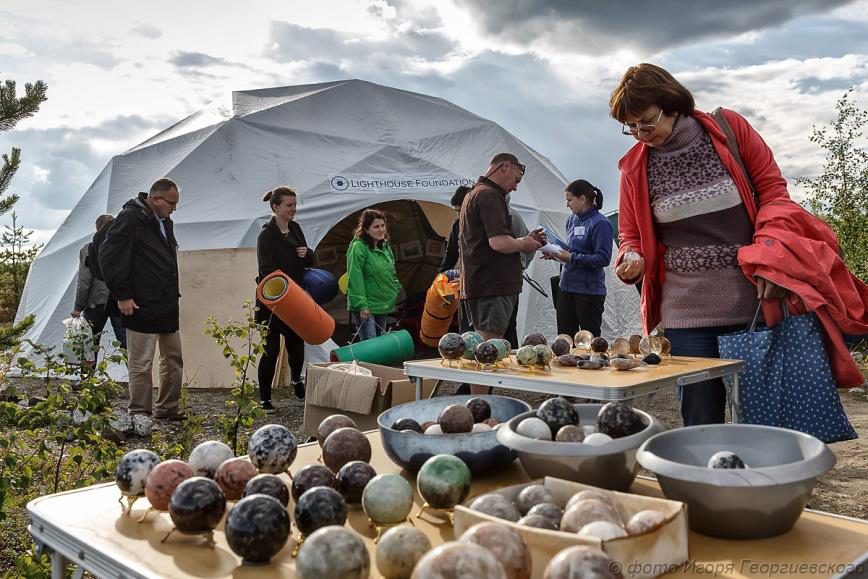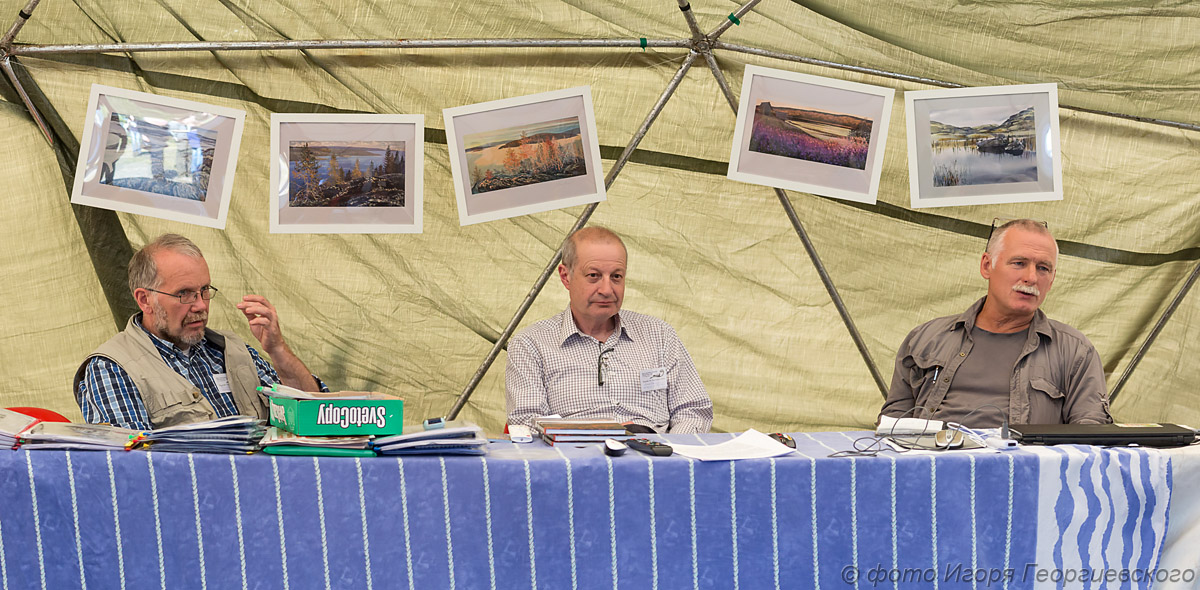- Lighthouse Foundation
- Projects
- Russia: Chupa, Karelia - far up in the North
- Russia: White noise
Russia: White noise at the polar circle
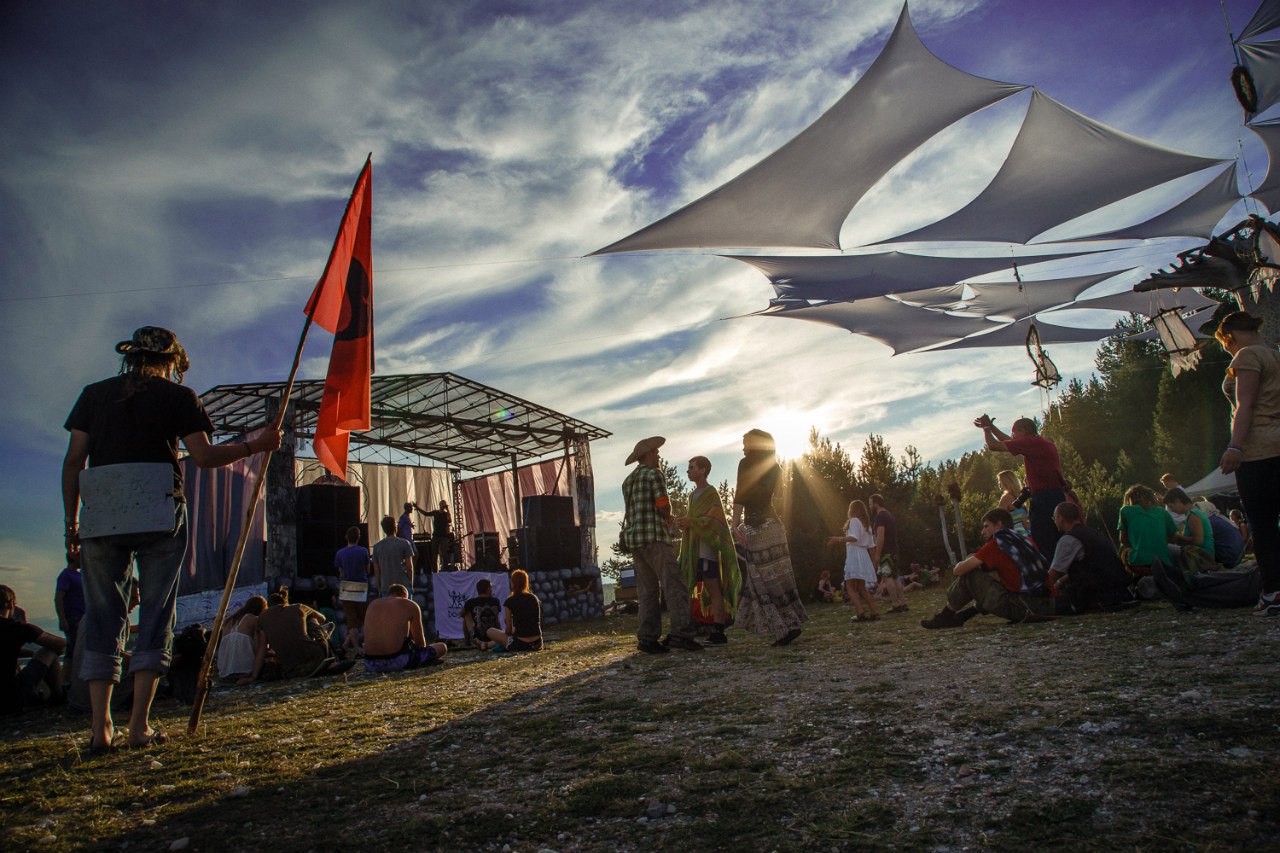
"White Noise" is an ecological arts and culture festival that takes place every year since 2010 on the shores of the White Sea. It is a platform for the creative potential of the people in the north and appeals to people from all over Russia.
White Noise 2016
"White Noise" is an ecological arts and culture festival held annually on the shores of the White Sea under the open sky near the village of Chupa. The festival also provided a great platform for the creative potential of the people in the north in 2016, and also appeals to people from all over Russia as well as international artists. The Regatta for the "Kandalaksha Bay Cup" organized by the festival is attended by numerous young people from the region.
The art festival "White Noise" has become an integral part of cultural life in Karelia. The festival is based on the principles of harmonious interaction between man and nature. Multiculturalism and freedom of expression give the festival a bright aura and identity. Because of its uniqueness, the festival "White Noise" is today an important contribution of event tourism in Karelia and enriches the economy and culture of the region. The festival takes place annually since 2010 in the middle of summer. The variety of geography around the venue offers extensive opportunities for activities. In addition to guests from Karelia, the 2016 festival attracted more than a thousand guests and participants from all other regions of Russia, as well as guests from Germany, Norway and Finland.
White Noise 2015
The festival took place on 16-18 July 2015 and offered a rich cultural program: performances by music groups from different cities of Russia as well as master classes, workshops, performances. The festival was attended by around 1,200 guests. In addition to the concerts and events held during the festival, visitors had the opportunity to get to know the amazing nature of the northern region, the traditions and culture of the people of Karelia. For this purpose, boat trips were organized into the surrounding area and art and crafts markets, where local artists and craftsmen showed paintings and sculptures or everyday items and offered for sale.
This year, for the second time, an environmental conference was held in conjunction with the festival. For this purpose, the large dome-shaped tent was erected at a new location, in which lectures and presentations were held on two days as it had been the previous year. Contributions to the conference focused on the natural and cultural heritage of the White Sea region. It was about the education system in general and the common cultural landscape.
The visitors were able to participate in the creation of art objects made of natural materials and to accompany the creative process. Objects that harmonize perfectly with the landscape, create a fabulous atmosphere and thus enhance the attractiveness of the place and the image of the festival. It becomes clear that it is not only our task to increase the flow of tourists and visitors, but above all to contribute to the preservation and improvement of the natural foundations of the territory.
The new project "Forest Park Medvezhka"
It was actively working on the project "Forest Park Medvezhka". On the one hand, efforts have been made to improve the infrastructure on the peninsula where the festival takes place. There is good cooperation with local authorities on this matter. The Mayor of Chupa supports such a path of development and for his part he promised to help with the construction of a driveway and other important strategic issues. It is also about securing the legal status of the peninsula in order to gain security and sound management of all tasks related to the festival.
White Noise 2014
It was already the fifth anniversary since the start of the event series. An extensive cultural program was organized, with performances by music groups from different cities of Russia, DJs, soloists. In total, about thirty music projects were invited, both popular artists and beginners. In addition, there was a group of artists with a fire show and circling performances. About 100 people, including a group of designers, were involved in shaping the festival. The number of visitors was again increased, certainly because of the advertising in social networks and the invitation of famous musicians. The public's interest in the festival is growing significantly and "White Noise", for example, reached the top ten most interesting festivals in Russia on the Internet portal http: // myfest.ru.
The event took place in a positive way without incidents and disruptions. In the run-up to the event, all important services were informed (police patrols, traffic police, rescue service, Federal Drug Control Service) and the operational readiness ensured. The festival was visited by around 1,200 guests from near and far. This is a good boost to the economy of the village, which provides food, accommodation, transfers and other services by local residents. Overall, the general mood in the population has improved, because for a long time something happens in Chupa also transparent from a cost point of view. High expectations are placed on the festival in view of the development of the urban area and the entire region.
For the first time, an environmental conference was held this year together with the festival in a dome-shaped, large tent. Scientists, graduate students and students from various academic institutions, regional and local government employees, and local guardians of the shared heritage participated in a conference in Chupa from 18 to 20 July 2014, working on various topics. A total of 58 people attended and 30 publications were presented mainly by the authors themselves, including employees of the Zoological Institute of the Russian Academy of Sciences (RAS), the Institute of Language, Literature and History of the Moscow State Lomonosov University, the Karelian Research Center of the RAS, the Shirshov Institute of Oceanography of the Russian Academy of Sciences, WWF - Russia and many other prestigious institutions of Russia.
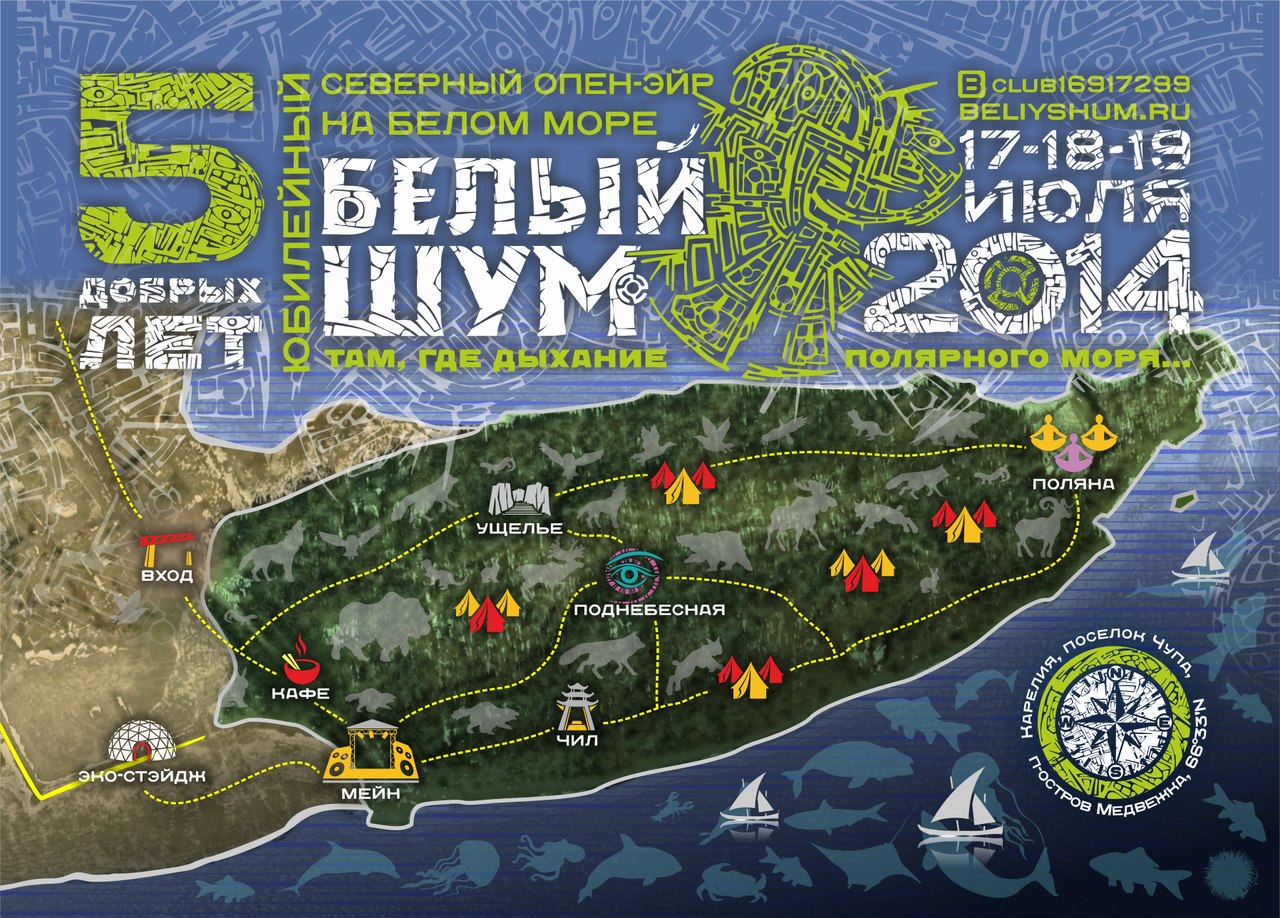
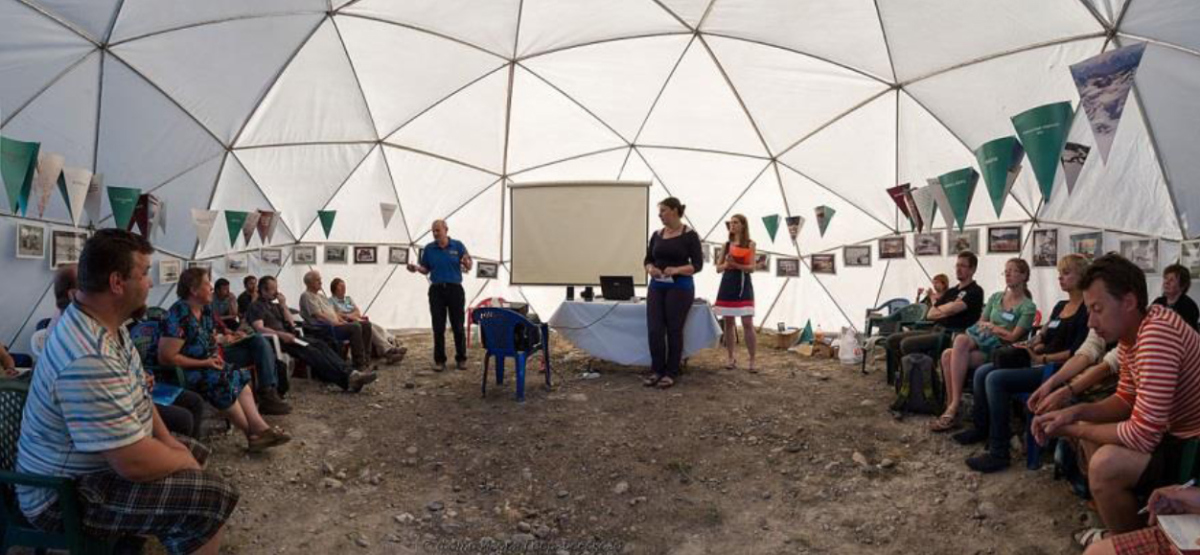
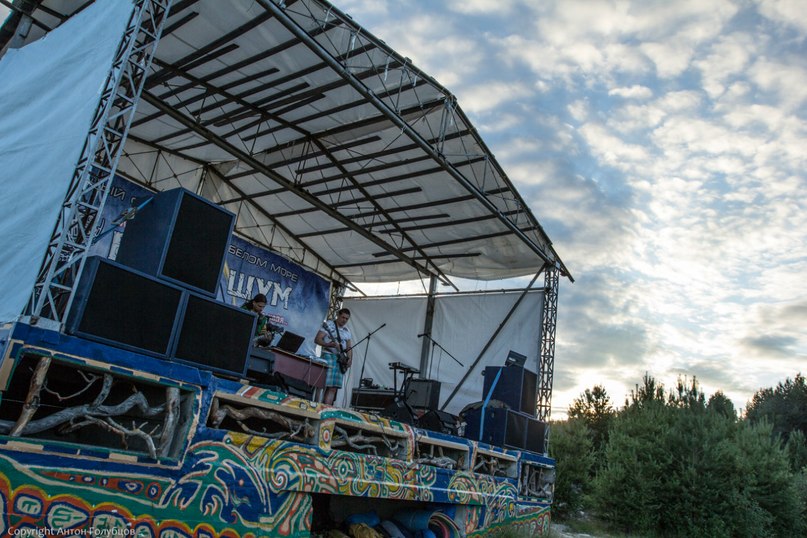
White Noise 2013
The official organizer of the 2013 festival was the "Non-Profit Partnership for the Organization of Major Cultural Events Karelia Festival", which was founded for this purpose. The local administration has actively supported the festival in terms of both administrative and site issues, as well as providing essential technical facilities and utility services such as bio-toilets, garbage collection and power supplies.
The festival also took place in connection with the regatta "Cup of Kandalaksha Bay 2013". Both events brought together a total of 750 guests from other regions and abroad, 600 of whom attended the festival and 150 the regatta.
An extensive cultural program had been organized: music groups from various Russian cities and even guest artists from Germany and Israel performed. Approximately thirty-five music projects had been invited, including both popular and previously unknown groups, DJs and soloists, as well as groups of artists performing fire shows and performances. In total, there were about 100 artists on site, including the organizers. The number of visitors increased significantly in 2013 due to active advertising in social networks and the attraction of the invited well-known musicians. The audience's interest in the festival is increasing markedly, according to internet portal myfest.ru the festival is one of the 10 most interesting festivals in Russia.
In addition to the festival performances, visitors were able to get to know the nature and culture of the local people. For this purpose, ship excursions and the craft market were organized as part of the festival, where products of local and foreign craftsmen as well as pictures and sculptures of artists were presented.
The festival was attended by about 700 visitors and local guests. The presence of foreign guests was a good incentive for the economy of the village, as services such as food, accommodation and transport are provided by local residents. This is conducive to the general mood among the population, as in Chupa nothing exciting and economically interesting had happened for a long time. There are great expectations at the festival and it is hoped that it will give new impetus to the development of Chupa.

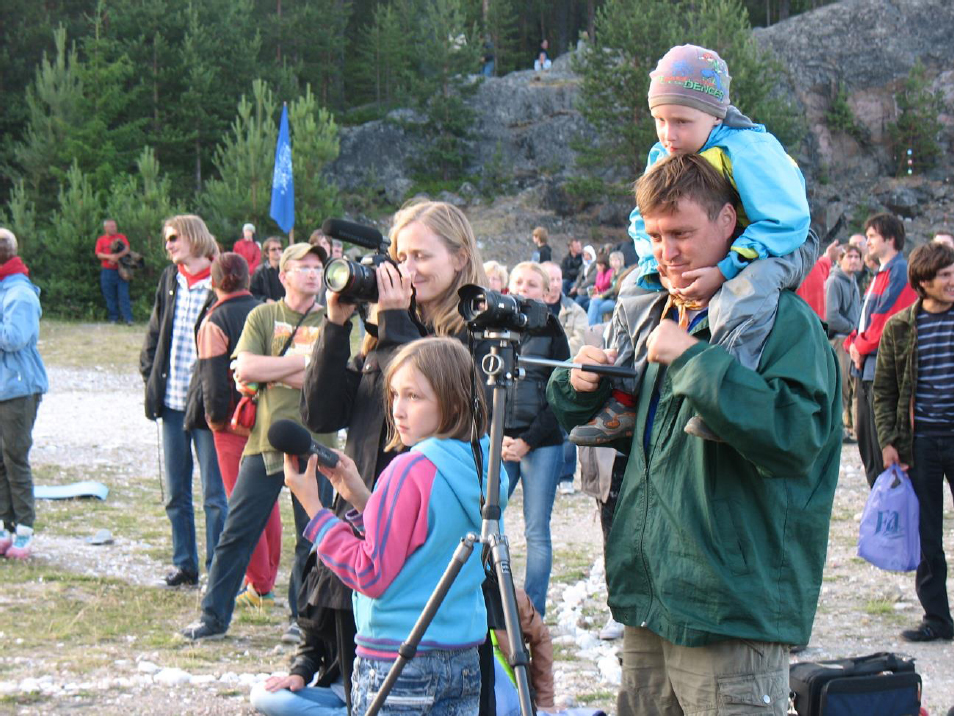
White Noise 2011
It was the second time in June 2011 the open-air festival "White Noise" to take place in Russian Karelia, Chupa, a place at the White Sea. 32 kilometers south of the Arctic Circle the old Karelian village Pomorski Chupa on the peninsula Medvezhka was venue for the annual festival.
The program shows young stars and artists of the Karelian music scene as well as musicians from other countries. Performances, various art projects, tours and a craft market at the shoreline are included. The organizers of the festival "White Noise" see their priority in the development and support of traditional, indigenous culture of the North. This includes familiarity with nature, as an appeal to one's roots, but also a modern interpretation.
Again in 2011, about 1,000 people of all age groups were counted. More than 200 of them came from distant cities of Russia, from Murmansk, Arkhangelsk, Severodvinsk, Kandalaksha, Petrozavodsk, St. Petersburg, Moscow, Bryansk, etc. The majority of the guests, however, were residents of the region and Chupas Louhi.
Yury Rybacov reported that despite of coldness and rain and difficulties in finding accommodation and meals, the people were so inspired by the nordic atmosphere that they want to come back next time. It is said that "it is difficult to opt for the North, but if you did, you will never forget it. Here you will find only the beautiful Nordic nature, the sea, and taiga.. "

White Noise 2010
In 2010 the festival took place on the peninsula "Vershinnyi" in the Chupa Bay of the White Sea. It was the largest music festival of Louhi region, the festival "White Noise". It was attended by about 1,000 people of all ages. More than two hundred visitors came from distant cities of Russia, from Murmansk, Arkhangelsk, Severodvinsk, Kandalaksha, Petrozavodsk, St. Petersburg, Moscow, Bryansk, etc. The majority of the guests, however, were residents of the region and Chupas Louhi.
60 musicians and 10 visual artists perormed the festival. An important aim of the festival is to support and promote nordic cultural traditions in all their forms and the cultural diversity of the peoples of the north. Therefore, the leitmotif of the festival and the selection criteria for the musicians and artistic groups was the ethnic component in the music, in their artistic projects and the works of artists and craftsmen.
In addition to the concerts of the festival the opportunity to experience nature played a significant role. To achieve these goals, several program issues were organized:
1st A craft fair with works from the region and beyond.
2nd A performance presented by guests from Severodvinsk.
3rd Several excursions to places that are typical for the northern region, such as a trip to the dolphinarium with beluga whales in the village Nilmoguba, a journey deep into the taiga to the highest vantage point that offers stunning views and sailing tours along the coast.
Highlights of the program were the "fakirs" with their fire show and a drum performance auus the musical project "Rhythm". The music program was made up of different styles. There was instrumental music from rock, ethno, folk and electronic music from ambient, trance, electro, progressive, lounge and chillout.
Despite the cold and rainy weather, the difficulties in finding accommodation and catering the northern landscape inspired the people and they want to come back. Just like the saying: "it is difficult to opt for the North, but if you've done it, you will never forget." An analysis of the project upon the background of the conditions in Chupa area makes up a positive perspectives, although there is still no real tourism in the region. The development of a tourism industry requires high investment, innovation, resources and personnel capacities. This is not characteristic for Chupa region. You find here only the beautiful northern nature, sea and tundra.
